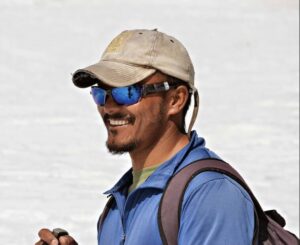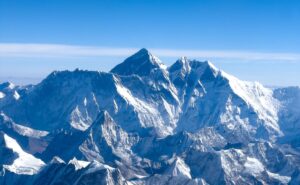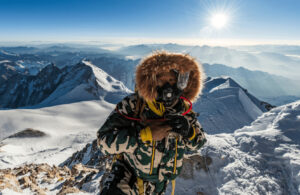Rumors had swirled in the climbing community for months. Eberhard Jurgalski and his team at 8,000’ers.com were about to release research that would change the history of alpinism. Well, the bomb has arrived.
History may or may not change but, at least, it has provided material for both heated debate and quiet reflection. Basically, Jurgalski states that only three people have really summited all 14 of the world’s 8,000m peaks.
In the new list, the first person to summit all of them was not Reinhold Messner, but American Ed Viesturs. Both he and the second on the list, Veikka Gustafsson of Finland, completed the challenge without supplementary oxygen. In fact, Gustafsson and Viesturs climbed together on a number of expeditions.
The bronze medal goes to Nirmal Purja who, on the same list, loses his Project Possible speed record. According to Jurgalski, Purja did not summit Manaslu and Dhaulagiri during his Project Possible race in 2019. Instead, he only reached sub-summits. He only properly topped out during follow-up climbs last fall.

Ed Viesturs with a piece of history in his hands – and new history in his resumé, according to 8000ers.com updated lists. Photo: Instagram
Moreover, Jurgalski claims that Purja knew from the outset exactly where the actual summits of those two mountains were, “because we spoke about it months earlier,” Jurgalski said. “Nearly secretly, he ‘corrected’ it in autumn 2021, when he went to the true summits of both mountains.”
Ten years’ work
Besides Jurgalski, the group of contributors includes Rodolphe Popier, Tobias Pantel, Damien Gildea, Federico Bernardi, Bob Schelfhout, and Thaneswar Guragai (of Seven Summit Treks). They have been diligently researching years of summit claims, especially concerning those tricky peaks whose highest points are easy to mistake. In recent years, the team has done a remarkable job to identify and describe all the features present in the summit areas of Broad Peak, Dhaulagiri, Annapurna, and of course, Manaslu.
You can download the complete list on 8000ers.com here.

ExWeb’s video interview with Eberhard Jurgalski.
Repeat or ignore?
Jurgalski first presented the new list in a long text on Facebook. He cited examples of great climbers who had not reached the highest points of their targeted summits. Jurgalski mentions, for example, an interview (which I did for ExplorersWeb back in 2008) with Iñaki Ochoa de Olza. In it, Ochoa admitted that a high number of climbers had stopped short of the true top.
Jurlaski explains that some climbers have, like Purja, returned to those mountains to “correct the mistake”. Others refuse to admit the error or simply ignore it.
“Most of the climbers do not want to accept the corrections, because they think their reputation will [diminish],” Jurgalski explains.
Not surprisingly, Reinhold Messner is one of those who dismiss this fact-finding exercise. In an interview with The New York Times, Messner declared, “If anybody thinks that what I did was BS, I can live with it. If it was just five metres below on this long ridge…” he added, referring to Annapurna I.

Messner climbed Annapurna with Hans Kammerlander in 1985. Photo: Pinterest
Trying to put a positive spin on the new firsts that this research opens up, the German chronicler points out that the first female 14×8,000m summiter is now open. Plenty of national records are also newly available. As for those who previously completed their list, and who these new findings now leave one or two peaks short, Jurgalski envisions cooperation between them to finish anew — Edurne Pasaban and Gerlinde Kaltenbrunner pairing up to repeat Manaslu, for example.
The fact is, however, that time has passed, and with it, our knowledge of mountain summits has vastly improved. Also, high-altitude climbing itself has changed. A lot.
The matter of interviews
“If Miss [Elizabeth] Hawley had known this back then, she would also not have accepted [those summits],” explains Jurgalski, referring to the Himalaya’s original arbiter of summits. “Now we have to correct it as independent and reliable chroniclers.”
But there is a difference. Hawley based her judgment on thorough interviews with the climbers themselves. The team at 8000ers.com has contacted some of them, mainly to ask for summit pictures, but has not spoken personally with others. Many of those whose summit resumé has been diminished are unfortunately not alive to object or explain.

Erhard Loretan on the summit of Dhaulagiri.
Reactions from those who are still alive have been scarce so far. But along with viral attention on social media, Jurgalski has attracted numerous critics, especially from fans of the dethroned climbers, from Jerzy Kukuczka to Erhard Loretan. Loretan ‘lost’ his Dhaulagiri summit, despite climbing the never-repeated East Face in winter 1985. Others mention some mistakes on the list.
Jurgalski defends his work
Yet he defends his years of obsessive work and the thorough investigation that he and his team have done. As he told ExplorersWeb, they didn’t want to rewrite history. It was the climbers themselves who chose to stop below the highest point, knowingly or not.
Having to remove the accomplishments of some of his own mountain heroes was particularly hard, he said.

Manaslu’s foresummit and summit as seen from a drone. Photo: Jackson Groves/Journey Era, 2021
He had been working with thousands of cases, but it was Jackson Groves’ drone footage of Manaslu that finally prompted him to update the list and share the information they had gathered. Jurgalski insists that the work they are doing is so huge that they simply cannot contact everyone personally, since they lack the resources. In his opinion, the photographic evidence is enough in many cases, removing the need to speak to climbers.
The Urubko case
The problem is that one of the climbers he didn’t contact was Denis Urubko. Jurgalski has tagged Urubko’s Dhaulagiri and Manaslu summits under his “no evidence” column, and Cho Oyu as “no summit by body of proof or clue”.
Urubko climbed Cho Oyu in 2009 via a new route on a risky, pure alpine-style push up the highly difficult south side. He climbed with Boris Dedeshko, and the two were awarded the Piolet d’Or for it.
Asked why that summit was questioned and if he had asked Urubko himself for details, Jurgalski said, “He told another person that he was not on the true top. We did not need to ask him about it.” The climb was not discussed by the Piolet d’Or jury, The Himalayan Database, or the American Alpine Journal.
Dedeshko described their Cho Oyu summit thus: “At 8:10 pm, we reached the summit plateau of Cho Oyu. The ridge widened, the slope diminished, and we could make out the far side, descending into Tibet.” So it seems that they actually traversed the summit plateau.

Denis Urubko at the Baltoro a few days ago.
Urubko is currently in Broad Peak Base Camp and is not reachable for a detailed conversation. But we will ask him as soon as he returns.
Popier: the classification method
We also asked Rodolphe Popier, a member of the 8000ers.com team, what they mean by “no summit by body of proof or clue.”
He explained: “We eventually chose to sort the ascents into two categories to make things simple: NO SUMMIT is the result for the ascents for which accounts and/or summit pictures eventually led to a negative body of clues/proofs; NO EVIDENCE is the result for ascents where we either haven’t been able to access the summit pictures or when the pictures are impossible to analyze (because of the time of night, bad weather, etc). But no evidence doesn’t mean no summit!”
How about Miss Hawley’s heirs?
The Himalayan Database team is aware of the updated lists. Billi Bierling made the following statement to ExplorersWeb:
I really appreciate Eberhard Jurgalski’s work, as he is very precise, and together with his colleagues, he has defined new parameters for Himalayan climbing. The Himalayan Database team will look into it and discuss what changes can be made. It will be very difficult to get 100% evidence for past ascents, as we don’t have photographic evidence for some of the climbs or some of the climbers are no longer amongst us. But even though I don’t think we can rewrite history, we may be able to make some adjustments in the future.

Billi Bierling on Dhaulagiri last spring. Photo: Billi Bierling
The vacant female throne
According to Jurgalski, no woman has ever summited all 14 8,000’ers. He has scratched both Edurne Pasaban and Gerlinde Kaltenbrunner’s summits of Dhaulagiri and Manaslu.
In their places, the strongest candidates to finish first are Dong Hong-Juan of China and Nives Meroi of Italy. Both repeated peaks after discovering that they had not reached the highest point. Each has just one re-do left.
Climbing with husband Romano Benet, Meroi returned to both Shishapangma and Dhaulagiri, after finding out that they had previously not reached the highest point. She only has to repeat Manaslu in order to be the newly crowned queen of thin air — or at least this version of it. She has never used supplementary O2 on her climbs. After bagging Dhaulagiri last spring, Dong only needs Shishapangma to finish her quest.
We have no contact with Dong, but we spoke to both Pasaban and Meroi to get their thoughts.
Edurne Pasaban: honesty rules
“When we climbed, we climbed to what we considered the summit, the highest possible point, as far as we knew,” Pasaban said. “We are a small group of friends, we knew everyone, we shared Base Camp, good and bad moments, summits, and all the information available. Each of us climbed according to our individual preferences and style, and we respected each other.”

Edurne Pasaban and her climbing mates on Dhaulagiri in 2008. Photo: El Correo
“I personally know almost all the climbers in the new list whose summits have now been questioned. In my case, this has happened 15 years after I finished my 14×8,000’er project. We are all climbers with a long career behind us. We climbed out of love for the mountains and adventure. All of us have a clear record of well-documented expeditions. If someone disputes our achievements, it’s their opinion. But I do honestly believe, and I am sure the rest will agree with me, that I summited all the 14 8,000’ers.”
Nives Meroi
Nives Meroi points to an obvious but important fact: “Logically, Jurgalski is right. The summit is a precise and indisputable geographical point, and his work is just about that. It is not an ethical evaluation of the climbs, how you got to the top, and what means you used. The only measured parameter is whether someone reached the top or not, not how they got there.
“But then, of course, putting Messner, Lorethan, and the like at the same level as the current summit-baggers (at least 95% of today’s mountaineers) sounds like a blasphemy.”

Nives Meroi at home in northern Italy. Photo: Nives Meroi
Meroi understands that the present work is just in its initial stage, the beginning of a precise investigation of each peak for each mountaineer. She also thinks there is long, difficult work ahead.
The question is, does she believe that she summited Manaslu? If not, does she feel up to going back?
“When Romano and I saw that drone image, we realized that we had not reached the true top of Manaslu, but only the point just before,” Nives explained. “If we had noticed this that day, we would have climbed all the way up. It certainly wouldn’t have been a problem for us to tackle that stretch, but unfortunately, in good faith, we were wrong.
“And yes, we have also thought it might be nice to go back to try to climb those last few metres for personal satisfaction, but thinking about returning there, with the circus that is on those mountains today…honestly, it makes us sick. And alas, trying it in winter is too expensive for us.”
Final thoughts
There is a chance that by trying to set things right, Jurgalski has shattered the entire system. A summit is, as Meroi rightly said, an indisputable location, the highest geographical point of a mountain. Thanks to technology, we now have more accurate ways to find out precisely where it is. As Meroi also said, reaching the summit is independent of style and ethics. If a helicopter touches the top of Everest, that is also a valid summit.
Yet considering the dozens of ascents that were done in excellent style but apparently stopped some metres below the highest snow bump, you can’t help but reflect about what really matters in mountaineering. Humans like lists of firsts and mosts. But sometimes the how is more important than when, how many times, or how fast. The process supersedes the result.
Some great climbers, who have inspired many of us since childhood, have been dropped from the list. Others are included, although they were guided to the top and supplied with everything, from O2 to breakfast in the tent. It makes us wonder whether we are promoting the wrong records.
In fact, does counting summits still make sense? Oxygen, ropes, trails, and Sherpa support provide rewarding personal achievements, but do not lead to extraordinary mountaineering.

Kristin Harila could well become the first female 14×8,000’er summiter, according to the new list. Above, on the summit of Annapurna. Photo: Kristin Harila
Attitude must also count. Messner thought he was on top of Annapurna. A large number of climbers swear they passed the end of the ropes on Manaslu, crossed a sharp ridge (or two), and stood in a place where clearly “everything else was downward”. Some (not many) might return to set foot on the highest point for the records, but is this in the spirit of mountaineering?
Finally, 8000ers.com’s work is thorough and serious, but it is not infallible. Some past summits are impossible to prove. Many climbers have died and cannot be consulted. Many reached what they believed was the highest point and that is enough for them. Except under certain circumstances, we still trust a climber’s word. In the same way, stating that all summits considered valid by 8000ers.com are real is a risky statement, despite the researchers’ skills and thoroughness.
Do we drop the greats?
At least the debate has started, which is positive. But the final question remains: Shall we demote the traditional list of pioneers, delete their stats, and start over? Should we wait for Harila, Tseng, Brownlee, or any of the current peakbaggers to take the throne?
From Mallory and Irvine, or Herzog’s Annapurna onward, there is too much mystery in expedition history. It is our duty to find out facts as far as possible, but I am not hopeful that we can solve the many enigmas or uncover many cheaters.
“Yes, the whole 8,000’er history must be rewritten. It is not our fault, but true is true and false is false, either by intention or by accident,” Jurgalski says.
To some extent, I disagree. Some changes will surely come, but I don’t feel ready to change history without providing context for each era.
As for present and future expeditions, we at ExplorersWeb will keep doing our best to encourage and demand transparency and solid evidence, now that it is easier to provide than ever, from every climber, polar skier, rower, or adventurer seeking to break a record.






